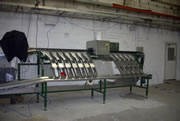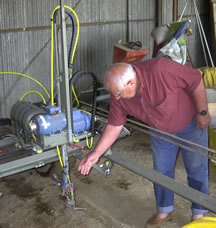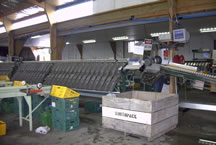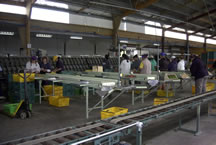Asparagus Research
by Trent Ball*
The Washington/Oregon asparagus industry has undergone significant adjustments in recent years, including rising labor costs and competition from foreign markets. Labor reduction, use of mechanical equipment, and value added products are essential for its survival. Consequently, grant money from the USDA is making research for asparagus industry solutions possible. The projects under evaluation have already provided prospective solutions to the problems the industry faces.
The long term focus will be to research the feasibility of using various production and processing facilities in a more efficient manner, evaluate the feasibility of adopting new technologies, explore the possible fuller utilization of current production, and solve or find solutions to technical barriers which inhibit the overall competitiveness of the industry.
A field research project was conducted over the course of the 2001 harvest season. Data was collected to develop parameters in creation of a feasible mechanical harvester. Moreover, growth trials were done over the second half of the harvesting season, which found that initial length, air temperature and spear distribution have an effect on the daily growth of the spears. Additionally, a trip to New Zealand was organized to evaluate technological advances they have made in harvesting and grading/sorting asparagus. A selective harvester was evaluated based on the layout of the New Zealand asparagus fields, the labor saving potential, and quality of the spears that are harvested. The harvester uses a laser to identify a spear at a designated height.
A new demonstration machine for grading and sorting asparagus for fresh packers was also showcased. The new techniques included color cameras, 3-D measurement, improved tip maturity measurement, better color determination, and various other features. Several sheds in New Zealand were visited that used the current grader machines. Initial results indicate that packing sheds using the grader/sorter are 25% more efficient than the current methods used in Washington. The machines reduce labor and increase productivity. If the new grader machines in development can increase production further they provide and opportunity for Washington packers to improve both in efficiency and labor savings.
A cost benefit analysis will be used to evaluate the current system of packing fresh asparagus in Washington compared to a mechanical approach. The estimated cost structures will be evaluated using financial analysis tools such as cash flows, net present values, and payback periods to demonstrate the economic incentives in the adoption of alternative technologies.



*Trent Ball is an Associate in Research, working with Dr. Ray Folwell, on the asparagus project. He recently, November 2001, traveled to New Zealand to study the asparagus industry there.
Pictures from research trip


Mechanical harvester cutter


Grader, above, and Sorter, below.

Heading using the h3 tag
Lorem ipsum dolor sit amet, consectetur adipisicing elit, sed do eiusmod tempor incididunt ut labore et dolore magna aliqua. Ut enim ad minim veniam, quis nostrud exercitation ullamco laboris nisi ut aliquip ex ea commodo consequat. Duis aute irure dolor in reprehenderit in voluptate velit esse cillum dolore eu fugiat nulla pariatur. Excepteur sint occaecat cupidatat non proident, sunt in culpa qui officia deserunt mollit anim id est laborum.